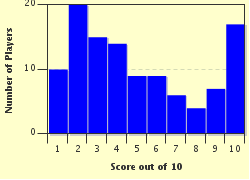Quiz Answer Key and Fun Facts
1. As well as having intrinsic muscles to alter its shape, the tongue has four extrinsic muscles to alter its position. Which of the four extrinsic muscles is NOT supplied by the hypoglossal (XII) nerve?
2. Which of the extrinsic muscles of the tongue pull the tongue forward out of the mouth?
3. Which of the palates, hard or soft, is able to move up and down?
4. The pharynx is surrounded by three constrictor muscles (superior, middle, and inferior) which, as their name suggests, constrict the pharynx. Onto which structure do these muscles insert?
5. The lower fibers of the inferior constrictor are tonically (continually) contracted to form the upper oesophageal sphincter. What name is sometimes given to these fibers, as if they formed a separate muscle?
6. Stylopharyngeus arises from the styloid process of the temporal bone in the skull and lies across the pharynx, some of its fibers joining with the constrictors, and some with palatopharyngeus. What is its primary action?
7. When the bolus is at the very back of the mouth, which of these does NOT facilitate its entry into the pharynx?
8. Generally speaking, the suprahyoid muscles work to elevate the hyoid bone and the pharynx during swallowing while the infrahyoid muscles do the opposite, depressing the hyoid bone. Which of these is NOT an infrahyoid muscle?
9. Swallowing causes a certain structure to open due to the contraction of a muscle called salpingopharyngeus. Which structure is this?
10. All phases of swallowing are voluntary.
Source: Author
reeshy
This quiz was reviewed by FunTrivia editor
crisw before going online.
Any errors found in FunTrivia content are routinely corrected through our feedback system.

